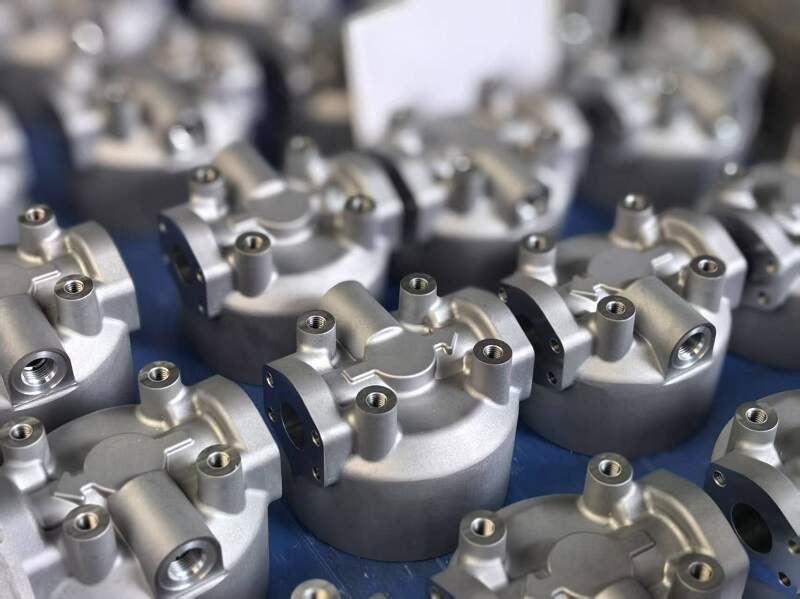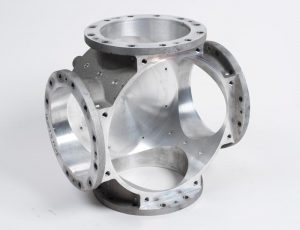Understanding the Environmental Benefits of Light Weight Aluminum Factory Techniques
Light weight aluminum shop strategies play an essential role in progressing sustainability within the manufacturing field. By implementing sophisticated recycling approaches and energy-efficient methods, these methods greatly decrease waste and carbon footprints. Cutting-edge casting approaches further boost source preservation efforts. As sectors significantly focus on environmental responsibility, recognizing the complete influence of these practices comes to be vital. What specific developments are blazing a trail in this change?
The Role of Light Weight Aluminum in Lasting Manufacturing
Although numerous products add to lasting manufacturing, light weight aluminum stands apart because of its distinct residential or commercial properties and recyclability. This light-weight steel is not only durable yet also has exceptional rust resistance, making it an optimal choice for various applications, from automobile to building and construction. Its high strength-to-weight proportion results in power cost savings throughout transportation and usage. Aluminum can be reused forever without losing its inherent high qualities, promoting a round economic climate.
The manufacturing process of aluminum has progressed, including energy-efficient approaches that reduce carbon impacts. By making use of renewable resource sources, producers are progressively lessening the ecological influence related to light weight aluminum manufacturing. In addition, making use of recycled light weight aluminum needs considerably much less power contrasted to extracting and fine-tuning primary aluminum, causing lower greenhouse gas discharges. As markets look for lasting solutions, light weight aluminum's adaptability and environment-friendly characteristics setting it as a critical product in the search of greener manufacturing methods.
Advanced Recycling Techniques in Aluminum Foundries
Advanced recycling techniques in aluminum factories are reinventing the way scrap aluminum is refined and recycled. Innovative techniques, such as closed-loop recycling systems, make it possible for shops to reclaim aluminum from production waste and obsolete products efficiently. These systems decrease worldly loss and enhance the high quality of recycled aluminum, making it a sensible option to main aluminum production.
Furthermore, advanced sorting technologies, consisting of automated optical sorting and X-ray fluorescence, enhance the splitting up of light weight aluminum from various other products, ensuring greater purity levels in recycled outcomes. This accuracy decreases contamination, which can endanger the honesty of the end product.
In addition, the assimilation of sophisticated melting technologies, such as induction melting and energy-efficient heating systems, enhances the recycling procedure, reducing energy usage. Collectively, these advancements add to a more lasting aluminum industry by reducing reliance on virgin products and decreasing greenhouse gas exhausts connected with light weight aluminum production.
Energy Performance Improvements in Shop Procedures
Power efficiency enhancements in aluminum shop procedures can considerably enhance sustainability techniques. Executing waste warmth healing systems enables foundries to repurpose excess power, minimizing general energy usage. In addition, improvements in process automation enhance procedures, leading to reduced waste and maximized resource usage.
Waste Warmth Recuperation
Implementing waste warm recovery systems in light weight aluminum shops substantially boosts power effectiveness by catching and recycling excess thermal energy generated during production processes. These systems promote the conversion of wasted heat right into useful power, which can be made use of for numerous applications within the shop, such as powering or pre-heating products devices. By recuperating heat that would certainly or else be expelled right into the setting, foundries can considerably lower their total power intake and greenhouse gas emissions. This approach not only reduces functional prices but additionally promotes sustainable practices within the industry. In addition, the fostering of waste heat recovery technologies aligns with governing standards focused on lowering ecological influence, making it an essential component of contemporary light weight aluminum factory procedures.
Process Automation Perks
Automating procedures in light weight aluminum foundries can substantially enhance power effectiveness by enhancing production workflows and minimizing waste. By carrying out sophisticated technologies such as robotics and artificial intelligence, factories can improve operations, decreasing unneeded energy consumption. Automated systems promote accurate control over temperature and material handling, making sure that energy is made use of just when required. Furthermore, real-time monitoring enables prompt modifications, reducing the threat of power loss. The combination of automation not just boosts productivity but also lowers functional prices, making shops more affordable. Therefore, these energy-efficient methods add considerably to sustainability objectives, lowering the ecological footprint of light weight aluminum manufacturing while fulfilling enhancing market needs - Aluminum Casting Company. Improved power performance through automation stands for an essential action in the direction of greener foundry procedures
Reducing Waste Via Cutting-edge Casting Techniques
Ingenious spreading techniques play an important role in minimizing waste in aluminum foundries. Methods such as sophisticated molding and the usage of recyclable products considerably reduce production scrap. These practices not just improve performance yet additionally add to a more lasting manufacturing procedure.
Advanced Molding Techniques
As industries increasingly prioritize sustainability, advanced molding methods in aluminum foundries become efficient services for reducing waste. These cutting-edge approaches, such as 3D printing and accuracy mold and mildew production, substantially improve the performance of the spreading procedure. By using computer-aided design (CAD) and simulation technologies, makers can maximize mold geometry, lessening product usage while maintaining product integrity. In addition, progressed techniques enable the production of intricate forms that typical approaches can not achieve, reducing the requirement for extra machining and thus lowering scrap material. The versatility of these methods enables for rapid prototyping, additional decreasing preparations and energy intake. Generally, the execution of advanced molding strategies stands for a crucial step towards ecologically liable aluminum production, lining up with global sustainability objectives.
Recyclable Product Utilization
Recyclable products play a critical duty in reducing waste within aluminum factories, transforming the spreading landscape with their effective usage. By integrating scrap light weight aluminum and various other recyclable elements right into the production process, shops can greatly lower the need for virgin products. This not only preserves natural deposits yet likewise lessens energy intake connected with mining and refining. Cutting-edge casting methods, such as die casting and sand casting, enable smooth combination of these materials, guaranteeing top quality results. The usage of recyclable products promotes a circular economy, where resources are constantly recycled and repurposed, decreasing land fill payments. Ultimately, the critical usage of recyclables boosts sustainability while promoting cost-effectiveness in light weight aluminum factory operations.
Reducing Production Scrap

Life Process Analysis of Light Weight Aluminum Products
Although light weight aluminum is widely recognized for its light-weight and durable properties, an extensive Life process Analysis (LCA) exposes the environmental influences linked with its manufacturing, use, and disposal. The LCA procedure checks out the energy consumption, greenhouse gas emissions, and source depletion connected to aluminum items from removal of bauxite ore to end-of-life administration. Key aluminum production is energy-intensive, commonly counting on nonrenewable fuel sources, which adds substantially to carbon impacts. In comparison, recycling aluminum provides considerable environmental benefits, as it uses just a portion of the energy required for main manufacturing. Furthermore, the recycling process decreases land fill waste and saves natural deposits. The LCA likewise takes websites into consideration the product's long life and potential for reuse, emphasizing the significance of sustainable style. On the whole, comprehending the life cycle impacts of light weight aluminum products is necessary for making notified decisions that focus on ecological sustainability within the market.
Situation Researches: Successful Lasting Practices in the Sector
The light weight aluminum market has begun to accept cutting-edge lasting techniques that deal with the ecological difficulties recognized in Life process Evaluations. One significant instance is a leading foundry that executed a closed-loop recycling system, substantially decreasing waste and power consumption. By reusing scrap light weight aluminum in manufacturing, the center accomplished a 40% decrease in its carbon footprint.
An additional example involves a supplier that adopted renewable resource resources, powering its operations with solar and wind power - Aluminum Foundry. This shift not just reduced greenhouse gas exhausts however also enhanced the company's online reputation amongst environmentally conscious consumers
In addition, a 3rd shop has bought innovative spreading strategies, which maximize product usage and minimize defects, even more decreasing resource consumption. These instance studies show that the aluminum industry is qualified of incorporating sustainable practices, showing both ecological responsibility and financial viability, ultimately adding to an extra sustainable future.
Often Asked Inquiries
Exactly How Does Light weight aluminum Compare to Various Other Metals in Sustainability?
Light weight aluminum is normally thought about much more sustainable than numerous metals because of its recyclability, lower power demands for Continue production, and minimized ecological influence. Its lifecycle efficiency goes beyond that of steel and copper in different applications.
What Is the Carbon Footprint of Aluminum Factory Processes?
The carbon footprint of light weight aluminum factory procedures differs, generally varying from 4 to 15 statistics heaps of CO2 per lots of light weight aluminum generated. Variables affecting this include power sources, technology, and the efficiency of procedures.
Are There Health Risks Related To Light Weight Aluminum Factory Workflow?

What Are the Prices Connected With Lasting Light Weight Aluminum Techniques?
The expenses related to sustainable light weight aluminum techniques consist of higher initial financial investments in modern technology, possible increases in operational costs, and recurring upkeep. These are usually offset by long-lasting savings and minimized environmental effect.

Just How Does Light Weight Aluminum Recycling Influence Local Communities?
Light weight aluminum recycling positively influences local communities by producing work, decreasing garbage dump waste, and lowering power expenses. It cultivates economic growth and advertises ecological stewardship, bring about healthier living conditions and enhanced neighborhood engagement in sustainability campaigns.
Additionally, the usage of recycled light weight aluminum requires considerably much less energy contrasted to extracting and refining key light weight aluminum, leading to reduced greenhouse gas discharges. Advanced recycling methods in light weight aluminum foundries are revolutionizing the method scrap aluminum is refined and reused. Aluminum Casting Company. Carrying out waste heat healing systems in aluminum shops substantially enhances power performance by capturing and recycling excess thermal power produced throughout production procedures. Automating procedures in light weight aluminum shops can significantly boost energy effectiveness by enhancing production workflows and reducing waste. The carbon impact of light weight aluminum shop procedures differs, normally varying from 4 to 15 metric bunches of CO2 per lot of light weight aluminum about his created